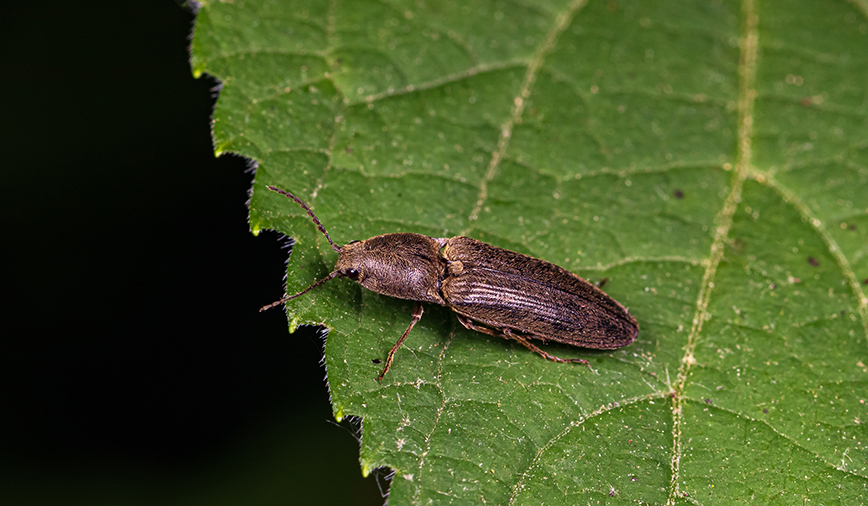April 24, 2015
Click Beetle
Ampedus nigricollis is just one of several species of click beetle present in Kane County. The insects belong to the family Elateridae, a name derived from the Greek word elat.r meaning ‘driver, or hurler’, a reference to the beetles’ way of hurling into the air when they click.
Did you ever stop to consider just how many parts of your day involve clicks?
Do you “click here” when web sites invite you to request more information? Do you remember to “Click it or ticket” when you get in your car? When you change channels on the TV, do you use a “clicker?” (Bonus question: Do you remember when remotes actually “clicked”?)
The other day at Hickory Knolls, we were clicking like mad. Well, not us so much as our little visitor Ampedus nigricollis, a small, brownish click beetle.
The little guy, or gal, appeared in our office courtesy of coworker Lisa O’Brien, who had been outside prepping for Bug Biographies, a school program we offer to second-grade classes. She noticed the beetle crawling on a hunk of bark that had fallen from a dead ash tree, and thought it worthy of further investigation.
Lisa said she wondered whether the bug could be an emerald ash borer, that dreaded killer of ash trees, that had somehow managed to survive our winter season as an adult. (Like most beetles in our area, EABs–which were introduced from Asia–typically overwinter in the larval stage.) Although similar in size and shape to an EAB, the insect lacked the brilliant “emerald” green color for which EABs were named.
But looking at the beetle with the aid of some magnifying lenses, it quickly became clear that this bug was no EAB. Most obviously, it lacked the large, googly, space alien-like eyes I’ve always associated with EABs.
So, one species down, 24,999 to go. (Coleoptera, or the beetles, is the largest insect order in the world. At 390,000 species and counting, worldwide, beetles account for 40% of all known insects and 25% of all known animal species. The count for North America right now stands at about 25,000 described species, with an estimated 3,000 more yet to be discovered. Thanks to volunteer naturalist staff at BugGuide.net for compiling those astounding figures!)
We quickly eliminated the native borers and were moving onto some of the other more common beetle families when one of us—not sure if it was Lisa or I—got the idea that we should try to pick up the bug to get an even closer look.
And that’s when something clicked.
The beetle, no doubt irritated with this rude infringement on its freedom, flexed its body and let out an audible click. That motion, in turn, helped something click in the dusty nether-regions of my brain.
A-ha!
I suddenly recalled the spring afternoon several decades ago when I found my first click beetle. A nature-nerdy fourth grader, I’d recently read about this unique group of insects and was over-the-moon thrilled to have found one underneath a rock by my parent’s front step.
Gifted with a unique mechanism—a spine that locks into a notch on the insect’s underside—click beetles have the amazing ability to click, or pop, themselves upright if they should find themselves upside down.
That day at my parents’ house, I remember spending a good chunk of time sitting alongside with little Clicky, relentlessly turning him over on his back and then watching him flip up into the air and land on his feet. Absolutely a-mazing!
To say I was similarly rapt with this latest click beetle would be only a slight exaggeration. Turn it over, watch it flip. Clasp between thumb and index finger, feel it snap. Hold in hand, listen to it click. The fun could very well have been endless that afternoon, except for the fact that the beetle eventually began to show some signs of tiring. Plus, I had work to do. I knew it was time to snap (click?) a few photos, then let the little guy go.
Worn out and probably more than a little irked, Clicky II nonetheless still had a few good clicks left, which made photographing the clicking mechanism next to impossible. I settled for a few shots of the beetle’s topside, made a few notes regarding date and location, then placed the beetle and its hunk of bark back outside where they both belong.
This coming week’s forecast calls for warmer weather, which means arthropods of all types will be on the move. If you’re out and about and have the opportunity, try tipping over a rock or rolling over a log (of course remembering to put it back when you’re done.) Look carefully among the ants, millipedes, centipedes and spiders to see if you can spot a beetle or two.
You never know, you just might find something that clicks for you.
Pam Erickson Otto is the manager of nature programs and interpretive services at the Hickory Knolls Discovery Center, a facility of the St. Charles Park District. She can be reached at 630-513-4346 or potto@stcparks.org.

